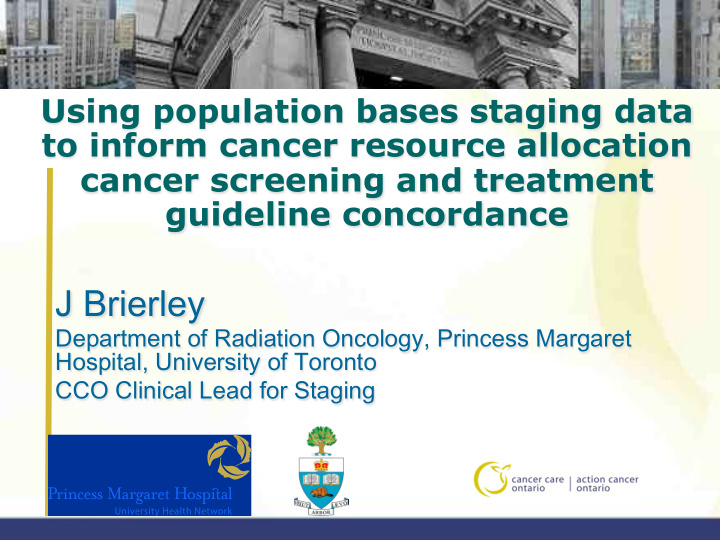



Using population bases staging data to inform cancer resource allocation cancer screening and treatment � guideline concordance � ����������� ���������������������������������������������������� �������������������������������� ������������������������������� � � �
Use of Population Stage Data 2
ONTARIO 13 Million Larger than France and Spain Combined The Stage- Path Project provides a rich dataset of cancer information for Ontario
Stage Project goal is to expand to population based stage data capture Final 90% of all cancer cases are staged Target Target -- 74% stage capture (2009) Actual -- 47% stage capture (2008) -- 33% stage capture Baseline (2007) Ontario
90% of Ontario pathology reports completed in January 2011, were synoptic - January 2011 5 !
Stage Distribution, Breast, Colorectal, Lung, Prostate Cancer 2008
Indicators for screening
20% Colorectal Cancer IV
75% Lung Cancer III or IV
Indicators for resourses
Lung Cancer by Region The distribution of stage IV cancer ranges from 43% to 54%
Stage Distribution and Regional Variation • The health care needs of the region for treatment costs, palliative care costs may be higher in regions were there is more stage IV cancer than others
Indicators for resection rates by stage
Region Variation in treatment - Surgery
Region Variation in treatment - Surgery • The rate of surgical resection in non small cell lung cancer in Ontario varies from 13% to 28% • This could be explained by more early cases in the LHIN with the higher rate • Linking surgical treatment to stage show that in one region 54% of stage I patients have surgery compared to 78% in another LHIN • Other explanations must be looked for
Indicators of treatment rates by stage
The percentage of stage II and IIIA resected cell lung cancer treated with chemotherapy or radiation therapy or both
Regional Variation in Treatment Guideline Concordance • Ontario has a mature program in Evidence-Based Care • Adjuvant platinum based chemotherapy is recommended in completely resected stage II and III non small cell lung cancer • Compliance overall is 56% but varies from 32-66% • The reasons for this can be investigated and further physician education is required
Indicators of survival rates by stage
The one year relative survival by stage at diagnosis by LHIN and Ontario for non small cell lung cancer
Regional Variation in Survival • Survival by stage and region can be determined • One year survival in patients with stage IV cancer varies by region from 15%- 31% • Reasons for this require further investigation
Conclusions • Adding stage data to other data collected by a cancer program greatly enhances that data • It can be used to measure the effectiveness of screening programs, determine health care needs by region and determine variations in treatment practice • Further communication and investigation of data quality and clinical practice is needed to assist with better understanding the variations detected
Recommend
More recommend